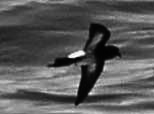I’ve just witnessed a miracle. Probably. On January 2 I took part in a trip to the outer Hauraki Gulf to search for a bird that until recently had not been seen since the nineteenth century. Three specimens of the bird, the New Zealand Storm Petrel, sitting in museums in Paris and London, were believed to be the only representatives of yet another of this country’s extinct species.
Then in January 2003 a bird matching the New Zealand Storm Petrel’s description was photographed off Whitianga. By itself that didn’t mean too much; sometimes you get strange individuals of common species, and this bird’s resemblance to the lost petrel may have been coincidence. But in November two British birdwatchers saw 10 or 20 birds just north of Little Barrier Island that looked just the same, and took some amazing photos (http://www.wrybill-tours.com/idproblems/stormpet3.htm). And our trip found at least three in the same area. Needless to say, we were over the moon. Here’s one of our pictures; not as good as the ones on the website, but clearly it’s the same thing.

So can a species really go more than a century without being recorded, less than 100km from Auckland? That’s what we skeptics would call an extraordinary claim, and quite correctly the Ornithological Society’s Rare Birds Committee isn’t rushing to confirm the bird’s continued existence.
But with every week that goes by, the case is looking stronger. Trips are now going out regularly, and amassing considerable documentary evidence. In the latest development, TV3 News has shown film of the bird. It’s all developing in a way that’s very different from sightings of moa, lake monsters, or Bigfoot, which are invariably isolated events with no follow-up. There’s definitely a bird out there in the outer gulf that wasn’t there before (at least not in any numbers), it looks just like the museum specimens, and not really like any other known species.
Possibly it’s an unexpected dividend of the rat eradication programme on our offshore islands; maybe a tiny population was able to hang on until the rats were gone, and they’ve bred up in the intervening years to the point where people are starting to see them.
Whatever the explanation, it looks like the biggest thing to happen in New Zealand ornithology since David Crockett rediscovered the Chatham Island Taiko in 1978, a mere 111 years after its last sighting. And it’s a reminder that however much we think we know about the world around us, nature can still spring surprises.

